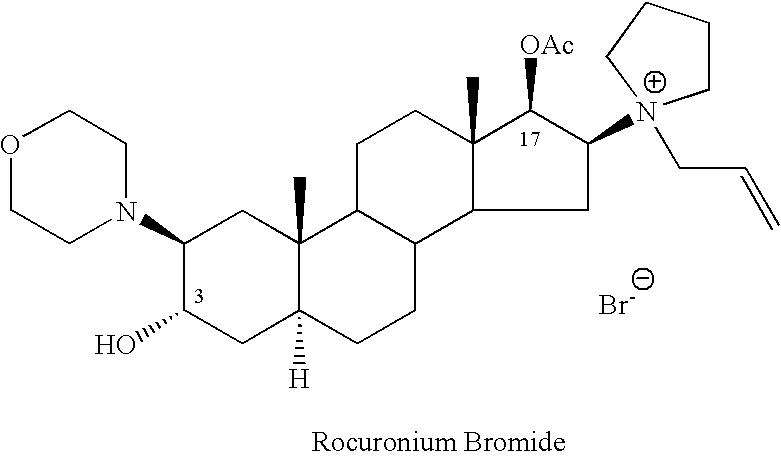Processes for the preparation of rocuronium bromide and intermediates thereof
- Summary
- Abstract
- Description
- Claims
- Application Information
AI Technical Summary
Benefits of technology
Problems solved by technology
Method used
Image
Examples
reference example 1
[0104] Acetyl chloride (1.92 ml, 0.027 mole) was added to a solution of (2β,3α,5α,16β,17β)-2-(4-morpholinyl)-16-(1-pyrrolidinyl)androstane-3,17-diol (Compound II, 10.7 grams, 0.024 mole) in 340 ml of dichloromethane. The reaction was set aside at room temperature (about 23° C.) for 18 hours. The pH was thereafter adjusted to 7.5 using 5% sodium bicarbonate solution. The aqueous phase was removed and the organic phase was washed with two portions of 50 ml of water, dried with Na2SO4, and the dichloromethane was evaporated to dryness to yield 7 grams of the crude residue as a crystalline mass.
[0105] HPLC analysis showed that the product included 67.2% of the desired Compound I, 7% of the starting material Compound II and 9.8% of the diacetate, Compound III.
reference example 2
[0106] The procedure of Example 1 was repeated at 40° C. The residue obtained, as determined by HPLC, was a mixture of 56.7% of the desired Compound I, 3.9% Compound II and 21.7% of Compound III.
reference example 3
[0107] The procedure of Example 1 was repeated at 0° C. The residue obtained, as determined by HPLC, was a mixture of 60.1% of the desired Compound I, 16.0% Compound II and 6.2% Compound III.
PUM
 Login to View More
Login to View More Abstract
Description
Claims
Application Information
 Login to View More
Login to View More - R&D
- Intellectual Property
- Life Sciences
- Materials
- Tech Scout
- Unparalleled Data Quality
- Higher Quality Content
- 60% Fewer Hallucinations
Browse by: Latest US Patents, China's latest patents, Technical Efficacy Thesaurus, Application Domain, Technology Topic, Popular Technical Reports.
© 2025 PatSnap. All rights reserved.Legal|Privacy policy|Modern Slavery Act Transparency Statement|Sitemap|About US| Contact US: help@patsnap.com



